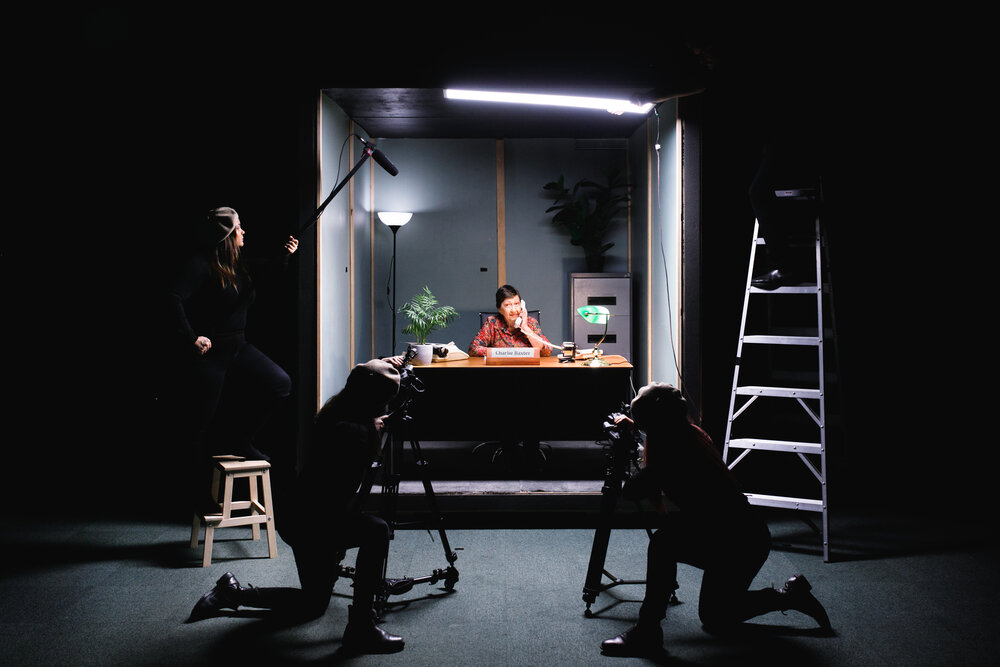The Heath Ledger Theatre audience bustles with anticipation on the night of Friday 5th March, as the actors of Whistleblower by The Last Great Hunt swarm the stage. As they emerge, pointing at whiteboards and interviewing the front row, they are in search of something in the crowd: the leading actor. Yes, you read that correctly. The play is about to start and the main character is not even aware that they are to be the star of the show.
Muttering over G&T’s, my friend and I speculate over what is about to take place; “I think those whiteboards are going to form the walls of the set” and “maybe that clipboard is an important prop for later”. Immediately, I am conscious of the core essence of this show; suspense and whispers. This production’s fuel is the endless ‘what if’ scenarios that are circling in each audience member’s brain, like a spider trying to link its sticky web together.
The tagline for this show: “the Truman Show meets an escape room live on stage”, is certainly apt for this multifaceted theatre production. The premise is simple — one audience member enters an escape room-like situation and interacts with real actors playing supporting roles as they proceed through five different scenes. What they don’t know is that every move they make is being spied on by the remaining audience through hidden cameras.
The main character, Charlie Baxter, who’s played by the chosen audience member, ‘wakes up’ in a hospital room with amnesia, clueless and script-less. The only thing they know is that their partner, Lex Harrington, was killed the previous night at a train station under suspicious circumstances. Not only that, but the police seem to think Charlie was involved. In true ‘whistleblower’ style, Charlie uncovers that Lex was working for a pharmaceutical brand, Link Biogen, that was manufacturing a drug which was killing people. As Charlie uncovers secrets and discovers the ugly truth about Link Biogen, the Whitleblower story seems to begin tying itself in a nice, neat bow. This is until Charlie learns that he also took the drug, and only has a few moments left to solve the mystery.
This interactive and immersive experience was unlike anything I have ever witnessed. The actors in this show – simultaneously operating lighting, controlling soundscapes and changing sets, all whilst acting as supporting characters in each setting, well and truly exceeded their roles and formed a cohesive ensemble that brought to life the magic of this production. I have never been so entranced by a piece of theatre that is essentially improvisation at its core. I was amazed by the ensemble’s ability to involve and interact with an audience in a way that wasn’t gimmicky or cringeworthy. The theatre was positively buzzing with electric energy after the show. Walking out through the foyer I felt invisible zaps from audience members brushing past, each with a unique perspective on the masterpiece that had just enfolded.
Despite it’s improvisational heart, this production was extremely well constructed, apparent through its meticulous writing and detailed set design. The world of this play was only seen through projections of what Charlie was seeing within the confines of the closed-off and soundproof set. As I followed along through the ‘Big Brother’ lens, the fact that the world of the play was still able to be communicated was fascinating. This videogame-esque experience, made for some frustratingly good moments of: “just open that briefcase already!” and “it’s that guy! That’s the guy whose name unlocks the safe!” Those ‘yelling at TV screen moments’ created some nail biting and suspenseful theatre. A production that is not only able to present interesting ideas, but subvert theatre as a form in its entirety, is something that is extremely impressive. The direction was clearly crafted to mess with typical theatre conventions as it manipulated situation and space, producing a truly unconventional experience for the audience.
The detailed set was constructed quickly by the supporting cast as soon as Charlie chose which room they were entering into; it’s ever-0adapting nature nicely alluding to the play’s overarching themes. The last room the player entered into, Joe’s Diner, which at this point was four black walls with Charlie’s full name scribbled floor to ceiling, intelligently demonstrated Charlie’s drug-induced delusions. Each set pointed towards his internal struggle with memory and reality; a clever device used to frame the narrative. The actors also worked with elements of physical theatre to personify Charlie’s experience of vertigo, building on the play’s experimentation with reality.
The plot was relatively simple and escape room-esque in nature with its dramatised storyline, typical settings, and heightened costuming. Yet, seeing something like this unfolding on stage was completely mind-blowing. While the storyline could be perceived as generic and clichéd at times, it is necessarily for the success of a play in which the main actor is clueless to his arc. The combination of the powerful video game-like soundscape designed by George Ashforth and elaborate set design that defied reality worked so well together in forging the bizarre relationship between the audience and supporting ensemble.
Overall, this stupendous multi-media production was something I will never forget. It’s equally annoying and difficult to capture the experience of this production, as it was so deliciously nuanced and gloriously engaging. I would absolutely recommend this production to anyone looking for a phenomenally entertaining and stimulating theatre experience. While unfortunately the run of this show has now finished, I would seriously recommend checking out The Last Great Hunt’s work in the future, and keeping a watchful eye for encore seasons.
5 Pelicans out of 5.
Courtney still hasn’t gotten over her fear of audience participation.
Words by Courtney Withers
Image courtesy of Daniel James Grant.

